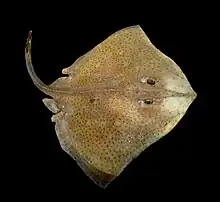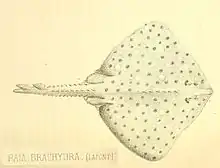短尾鰩
短尾鳐为鳐科鳐属的鱼类,分布于北至设德兰群岛和北海、南至毛里塔尼亚领海与马德拉群岛的大西洋水域[3]、地中海和爱琴海,而在黑海是否有分布则尚不清楚[4][3]
| 短尾鰩 | |
|---|---|
 | |
| 科学分类 | |
| 界: | 动物界 Animalia |
| 门: | 脊索动物门 Chordata |
| 纲: | 软骨鱼纲 Chondrichthyes |
| 目: | 鳐目 Rajiformes |
| 科: | 鳐科 Rajidae |
| 属: | 鳐属 Raja |
| 种: | 短尾鰩 R. brachyura |
| 二名法 | |
| Raja brachyura Lafont, 1871 | |
| 異名[2] | |
| |
外貌描述
同其他鳐鱼一样,短尾鳐身体扁平,胸鳍为翅膀形状,外貌类似于风筝。其尾巴比其他鳐鱼要短,体长为40cm-120cm[5]。值得注意的是,该鱼的身体上部上有数量众多的黑色斑点,在边缘的斑点较小且模糊,这是它关键的鉴别特征。[6][5]。

1873年描述该物种的科学家所画的插画[7]
生活习性
短尾鳐主要栖息在10-300m水深的沙质海底上,在北大西洋地区也有可能栖息于更深的地方。同其他鳐鱼一样,该鳐鱼的主要食物为底栖的小型鱼类、甲壳类和软体动物,其猎物体型亦会随年龄增长而增大。例如,年幼个体一般会捕食小型的甲壳类,而成年个体猎物主要包括龙虾和海鳗[8]。
同其他鳐鱼一样,短尾鳐为卵胎生物种,在2-11月产下幼鱼,一般会将幼鱼产在沿岸的浅水中,孕期为7个月[3],一年最多可产出30条幼鱼。幼鱼在孵化前完全由卵黄提供营养。人类对其生殖的其余信息所知甚少。[5][1]
物种现状
由于短尾鳐为底栖鱼类,其常常作为副渔获物被拖网捕获并作为食用鱼出售,同时也是受欢迎的海钓鱼品种,而希腊和摩洛哥则有捕捞该鱼作为装饰品的习俗。[9][10]在葡萄牙沿海,44%的商业捕鱼船在抵达码头时都会捕获至少一条短尾鳐[11]。在近几十年,许多地中海国家对大陆架和海底斜坡的拖网打捞技术愈发发达[12],导致该鱼数量显著减少[11],有统计指出目前平均需要超过330次撒网才能在地中海捕获一条短尾鳐[4]。在地中海之外,爱尔兰等国家也出现了该物种种群的衰退[8]。
文献索引
- Ellis, J.; Ungaro, N.; Serena, F.; Dulvy, N.K.; Tinti, F.; Bertozzi, M.; Pasolini, P.; Mancusi, C.; Noarbartolo di Sciara, G. . The IUCN Red List of Threatened Species. 2009, 2009: e.T161691A5481210 [20 November 2021]. doi:10.2305/IUCN.UK.2009-2.RLTS.T161691A5481210.en
 .
. - . WoRMS. [26 June 2021].
- "Raja brachyura". WoRMS. World Register of Marine Species. Retrieved 26 June 2021.
- Baino, R., Serena, F., Ragonese, S., Rey, J. and Rinelli, P. 2001. Catch composition and abundance of Elasmobranchs based on the MEDITS program. Rapp. Comm. int. Mer Mèdit 36: 234.
- . www.marlin.ac.uk. [2022-08-13]. (原始内容存档于2022-08-13).
- Serena, Fabrizio (26 June 2005). Field Identification Guide to the Sharks and Rays of the Mediterranean and Black Sea. Food & Agriculture Org. ISBN 9789251052914 – via Google Books.
- Lafont, A. . shark-references.com. 1873 [26 June 2021].
- Ellis, J.R., Dulvy, N.K., Jennings, S., Parker-Humphreys, M. and Rogers, S.I. 2005. Assessing the status of demersal elasmobranchs in UK waters: A review. Journal of the Marine Biological Association of the United Kingdom 85: 1025-1047.
- Bauchot, M.L. 1987. Raies at autres batoidés. In: M. Fisher, M. Schneider and M.-L. Bauchot (eds), Fiches FAO d'Identification des Espècs pour les Besoins de la Peche. Méditerranée et Mer Noire. Zone de Peche 37. Revision 1. II, pp. 847-885. FAO, Rome.
- Holden, M.J. 1973. Are long-term sustainable fisheries for elasmobranchs possible? Rapports et Procès-Verbaux de Rèunions du Conseil International pour l?Exploration de la Mer.
- Machado, P.B., Gordo, L.S. and Figuiredo, I. 2004. Skate and rays species composition in mainland Portugal from the commercial landings. Aquatic Living Resources 17: 231-234.
- Colloca, F., Cardinale, M., Belluscio, A. and Ardizzone, G. 2003. Pattern of distribution and diversity of demersal assemblages of the central Mediterranean Sea. Estuarine and Coastal Shelf Science 56: 469-480.
This article is issued from Wikipedia. The text is licensed under Creative Commons - Attribution - Sharealike. Additional terms may apply for the media files.